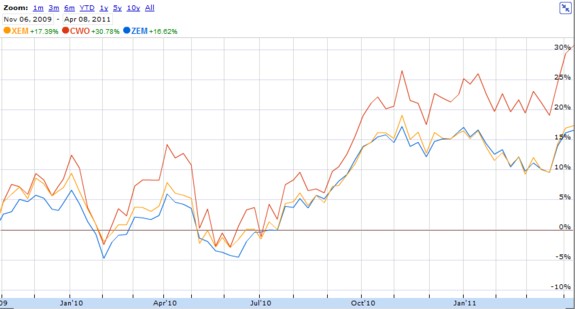

Last week I discussed currency hedging as it applies to international equity ETFs. While iShares hedges currencies in its MSCI EAFE Index Fund (XIN), it does not do so with another of its popular international funds, the MSCI Emerging Markets Index Fund (XEM).
This fund holds stocks in more than 20 countries, and these are denominated in their native currencies: the Chinese renminbi, the Brazilian real, the Indian rupee, and so on. So Canadian investors will be exposed to currency risk with this ETF: if the loonie appreciates against any of these foreign currencies, the fund’s returns will be lower. If these foreign currencies strengthen, the returns of XEM will get a boost.
BMO’s entrant in this asset class, the BMO Emerging Markets Equity Index ETF (ZEM), also does not hedge currency and therefore has the same risk exposure. Not surprisingly, ZEM and XEM have performed almost identically.
However, the Claymore Broad Emerging Markets ETF (CWO) has blown away the iShares and BMO funds. Since November 2009, CWO has climbed more than 30%, compared with about 17% for ZEM and XEM. What’s the reason for this dramatic outperformance?

The weird world of CWO
Claymore’s CWO simply holds the Vanguard MSCI Emerging Markets ETF (VWO), which is traded in New York in US dollars. According to Claymore’s website, the ETF adds currency hedging “to reduce the direct exposure to non-Canadian dollar currency risk for unitholders of such fund.”
What isn’t clear from this explanation is that CWO’s hedging strategy is pegged to the US dollar, even though the underlying stocks are not denominated in US dollars.
As I explained in last Monday’s post, US-listed ETFs that hold overseas stocks do not expose Canadians to the fluctuations in the US dollar. Why, then, does Claymore use such a strategy? The reason is that the managers have designed this ETF so it will deliver the same returns for Canadians that its Vanguard counterpart will deliver to Americans.
To understand this point, imagine three investors:
- Aaron is a Canadian who holds CWO. His ETF is denominated in Canadian dollars, and his returns are measured in Canadian dollars.
- Betty is a Canadian who holds VWO. Her ETF is denominated in US dollars, but her returns are measured in Canadian dollars.
- Carl is an American who holds VWO. His ETF is denominated in US dollars, and his returns are measured in US dollars.
Because of Claymore’s hedging strategy, Aaron and Carl will enjoy almost identical returns. Betty, meanwhile, will beat them both of them if the US dollar strengthens against the Canadian dollar, but lose to them both if the US dollar weakens.
I stress here that the currency hedging has no relation to the stocks in the fund. It is simply an active bet that the US dollar will decline against the loonie.
So far, so good
So far this gamble has worked out extremely well for CWO, because the US dollar has declined almost 17% against the loonie since the fund was launched in July 2009.
I’d be willing to wager, however, that only a tiny number of investors in CWO have the slightest idea how its hedging strategy works. Many probably selected CWO over its competitors because of its recent outperformance. But this outperformance cannot last indefinitely.
At some point, emerging markets are going to perform well during a period when the US dollar strengthens against the loonie. When that happens, investors in CWO will watch the value of their fund lag the index — and most will have no idea why.
It’s great that this hedging strategy has boosted returns for investors in CWO. But I have to question its logic. A Canadian who wants to invest in emerging markets shouldn’t be concerned with the strength of the US dollar versus the loonie. These are different investment risks that should have nothing to do with each other. CWO’s strategy makes as much as sense as buying an S&P 500 fund and placing a side bet on the Japanese yen.
I would love to hear from CWO investors who are learning about this for the first time: please add a comment below.










